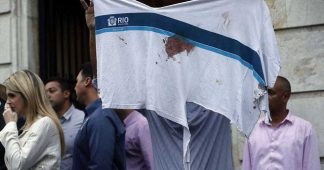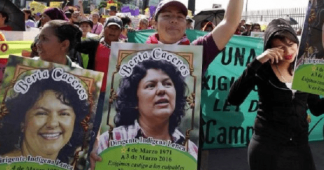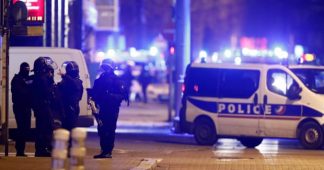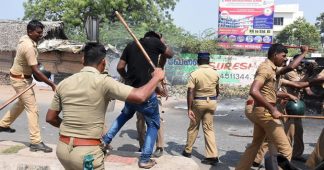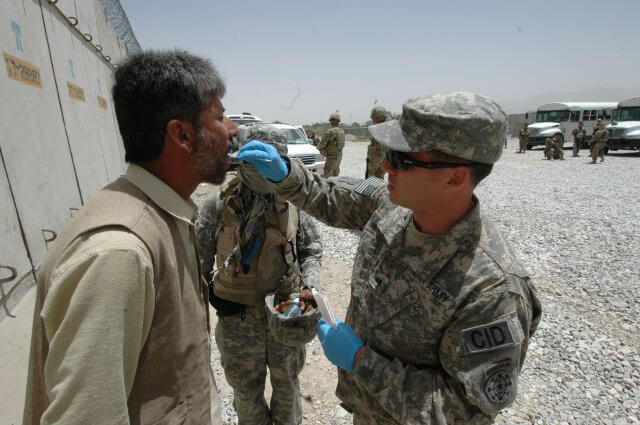Who Killed Marielle Franco? An Ex-Rio de Janeiro Cop With Ties to Organized Crime, Say Six Witnesses in Police Report
By Sérgio Ramalho
Last March, Rio de Janeiro City Council member Marielle Franco, a rising star in left-wing politics who regularly spoke out against police violence and corruption in her city, was assassinated by a gunman in an attack that also claimed the life of her driver, Anderson Gomes. Ten months later, no one has been arrested for the crime.
Now, however, six witnesses have identified a former officer in the police’s special operations unit as the man who pulled the trigger, according to a police report reviewed by The Intercept. The individual named in the report had previously been expelled from Rio’s Military Police force for involvement with one of the city’s main organized crime syndicates and has since became a full-time mercenary for illegal gambling rings, dirty politicians, and anyone else willing to pay for his services. His specialty: murder.
Last November, the Brazilian news channel Globo TV published two stories about the contents of the police report reviewed by The Intercept. But a state judge subsequently issued a gag order prohibiting Globo from publishing or reporting any more details from the document. Due to the sensitivity of the ongoing homicide investigation, The Intercept has decided to not disclose the suspect’s name.
Franco was killed as she was being driven home from an event on the evening of March 14, 2018, when a car pulled up alongside hers and unloaded a spray of automatic gunfire. The 38-year-old politician and her driver were instantly killed. The attack had been carried out in a carefully chosen location, and surveillance cameras at a nearby metro station had been switched off prior to the crime, suggesting a shocking level of sophistication and giving rise to speculation that powerful figures were behind the assassination. In the days after Franco’s killing, tens of thousands of mourners flooded the streets of Rio and cities across the country and around the world in acts of solidarity, creating massive pressure on authorities to solve the case that has not abated.
The witnesses cited in the police report had concluded that the hitman didn’t act alone. This would be in line with the way the suspect is known to work. The police wrote in their report that they believe at least two other former special operations officers from the same force — the Batalhão de Operações Policiais Especiais, known as BOPE — were involved in the killing.
BOPE Veterans
In Brazil, each state has a military and civil police force. BOPE, an elite unit within Rio’s Military Police force, was founded in 1978 to carry out hostage rescues and other lifesaving operations, but evolved into an urban warfare unit with numbers in the hundreds. Its members are known as “caveiras,” or skulls, and the unit’s sometimes brutal ends-justify-the-means approach to its work has been immortalized in films and cheered on by Brazilians who favor a tough law-and-order approach to societal problems.
It is an open secret that some BOPE officers also work for organized crime. Like the main suspect, the two other former BOPE officers are elite soldiers trained at taxpayer expense who now market their deadly skills to the highest bidder. One of them is a colleague of the main suspect from their police academy days, according to the Civil Police report.
The main suspect fingered by the witnesses, an ex-captain, already had close ties to organized crime when he enrolled in the Dom João VI Military Police officers’ academy before joining BOPE, according to the police report. Officials have long known that criminal syndicates recruit individuals to enlist in and infiltrate the police ranks. These individuals then run protection for organized crime, both on the streets and internally as informants.
The ex-captain got his start this way, working for “bicheiros,” illegal gambling clans, according to the Civil Police’s report, but the homicide detectives ruled out the possibility that bicheiros were responsible for Franco and Gomes’s murders. Instead, the police believe that the individual or individuals who ordered the crime are part of a militia, a type of paramilitary group comprised of current and former police officers, firefighters, soldiers, and municipal guards.
Old Crimes Offered a Lead
The Intercept reported last May that the main suspect had ties to BOPE, and the weapon used in the crime — likely one of three types of imported submachine guns — was rare on the streets in Brazil, but part of the arsenal of special ops commandos.
The Civil Police’s Homicide Division first arrived at the name of the suspect by interrogating potential witnesses and fleshed out their suspicions by reviewing unsolved investigations into the executions of two former police sergeants, Geraldo Antônio Pereira and Marcos Vieira de Souza. Souza, known as “Falcon,” was the former president of the Portela samba school and, at the time of his murder, was running for city council. Executed in 2016, both Pereira and Falcon had been investigated for involvement with militias and bicheiros.
In the case of Falcon’s killing, witnesses at the time told detectives that four hooded men carrying assault rifles conducted the hit. The group pulled up in front of his campaign headquarters in a silver Volkswagen Gol, and three of them got out of the vehicle, but only two entered the building. Falcon, unaccompanied by his security guards, was shot dead with bullets to the chest and head, before the assassins fled in their vehicle. More than two years later, detectives still have not identified the killers or the motive for the crime.
Pereira was also gunned down by assault rifle. His murderers used vehicles with cloned license plates and were exceedingly careful to leave no clues behind, exhibiting a level of sophistication on par with the attack on Franco and Gomes.
With these clues in hand, the most experienced investigators in the Civil Police — well-acquainted with Rio’s underworld — were able to draw up a short list of those capable of organizing such clean hits. On that list was the crew of former BOPE officers, including the ex-captain. Police investigators then hit the streets, concentrating their efforts in the region of Rio das Pedras, in Rio’s West Zone, where the former BOPE captain leads a crew of mercenaries. After scouring the area for security camera recordings, they finally located footage of the Chevrolet Cobalt used in Franco’s assassination. The car had been filled up at a gas station in Rio das Pedras on the eve of the crime.
“Ghost Weapon”
Franco’s killers employed a bevy of sophisticated measures to cover their tracks, including the use of what are known as “ghost weapons,” according to the Civil Police report.
The strategy is simple. For instance, as with the spoils of war, corrupt police are known to assemble arsenals of arms seized in the course of their work, usually from operations against drug traffickers. Most weapons are turned in, kept in the custody of the state, as is required by law. But the best pieces seldom make it to the Civil Police warehouse — they are diverted to the private stockpiles of dirty cops. Sometimes, these illegal caches are stored in the armories that the Military Police battalions operate out of.
The quantity and size of these arsenals is unknown, since there are no police records and most of the arms are imported illegally by organized crime groups. Suspecting that a “ghost weapon” had been used in Franco’s killing, Homicide Division detectives ordered all 9mm submachine guns to be collected from Military Police units, including BOPE, and undergo ballistics testing.
Militias and a City Council Member
Without enough material evidence to directly link the former BOPE captain’s posse to Franco and her driver’s assassinations, the Civil Police detectives dug deeper into unsolved homicide cases in which they thought the group of former BOPE officers might have been involved. In addition to the deaths of ex-sergeants Pereira and Falcon, the investigators dusted off the files on the 2011 murder of José Luiz de Barros Lopes, known as “Zé Personal,” and the April 2017 killing of Myro Garcia. The victims in those cases were, respectively, the son-in-law and son of the bicheiro moneyman Waldomiro Paes Garcia, known as “Maninho,” who was himself killed in September 2004.
After following the threads of these investigations, the police and prosecutors’ office opened a separate investigation last October into the involvement of militias in illegal land grabs and clay mining in the city’s West Zone.
The investigation produced enough evidence for warrants to obtain the banking, telephone, and personal records of Rio City Council member Marcello Siciliano, according to court documents obtained by The Intercept. The case also resulted in a search warrant on his house and office.
In court filings, prosecutors argued that Siciliano had participated in more than 80 real estate transactions involving land in areas dominated by paramilitary groups over the last 10 years. The documents also cite a negotiation between Siciliano and a businessperson involved in clay mining, whose brother was arrested on charges of militia involvement. The city council member has publicly denied any association with paramilitaries and said that the real estate negotiations were legal and registered in a notary’s office.
According to an O Globo report in June, Siciliano had been accused by at least one witness of having ordered the hit against Franco, but Siciliano has vigorously denied any involvement. The allegation, according to the O Globo story, came from a witness who is not named. In their account, the witness said Siciliano was associated with a well-known militia member, who the witness said was asked to do the hit on Franco. In his denial, Siciliano said he did not even know the militia leader.
This week, however, the militia leader’s driver was arrested on unrelated homicide charges and, according to another O Globo report, told police that he drove his boss to meet with Siciliano on multiple occasions — contradicting Siciliano’s previous claim.
Less than a month after Franco’s killing, a staffer in Siciliano’s city council office was gunned down in Rio, along with a retired police officer. Both had alleged militia ties. At the time, police sources told The Intercept that the killings may have been an attempt to “burn the records” — silence individuals who may have been involved or knew too much about the assassinations.
Franco’s mentor and political ally, Marcelo Freixo, has publicly cast doubt on this theory. “I do not see the possibility of Marielle’s death having any connection with our work with the militias,” Freixo told O Globo. “If the [public security] secretary says that the motivation is the land issue or is the question of the militias, this statement has to be accompanied by evidence.”
A Broken Street Sign
Ten months after the executions of Marielle Franco and Anderson Gomes, the Homicide Division and the Public Ministry at last seem close to putting together all of the pieces in this intricate puzzle. Gen. Walter Braga Netto, who led the federal government’s takeover of Rio’s public security apparatus until the end of last year, told the O Globo newspaper last week that investigations into the death of Franco and Gomes are advanced, and the results would come “soon.”
I could have announced who we think it was, or told Richard” — Gen. Richard Nunes, the former secretary of public security — “to do it, but we wanted to do a really professional job,” he said at a military event in Brasília.
Whether these pieces end up fitting together, however, may be up to Rio Gov. Wilson Witzel, who took office this month after promising during his campaign to “slaughter criminals” and end the civilian secretariat that oversees state police forces. This week, Witzel posted a video of himself leading a session of pushups at BOPE headquarters. Last year, a viral photo from a campaign event showed Witzel, microphone in one hand, the other raised in a fist, standing on stage next to two other candidates who proudly displayed a Marielle Franco street sign they had broken in half.
Published at https://theintercept.com/2019/01/17/marielle-franco-brazil-assassination-suspect/
